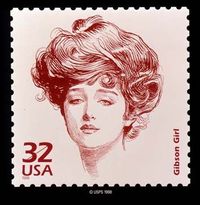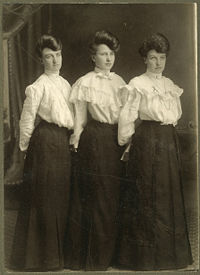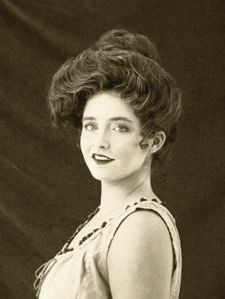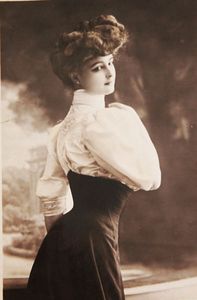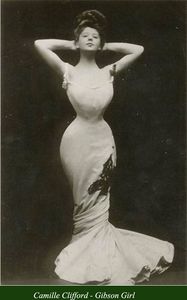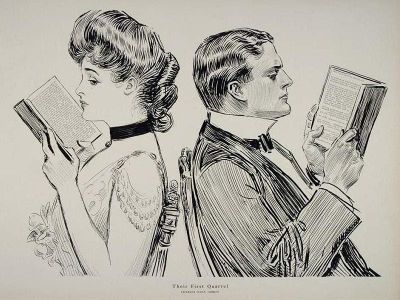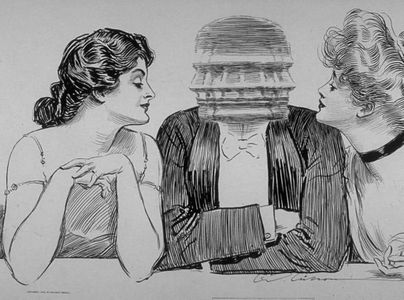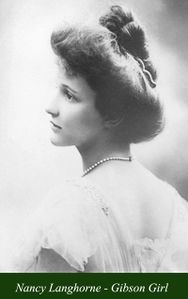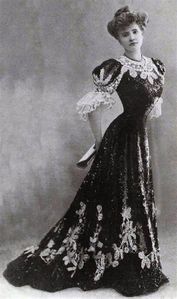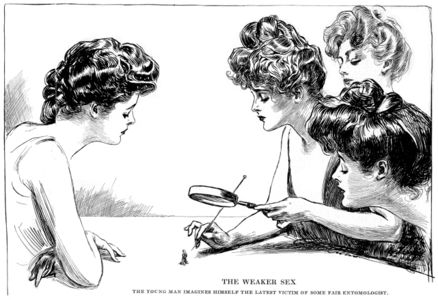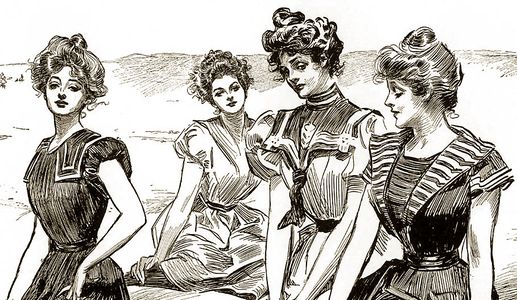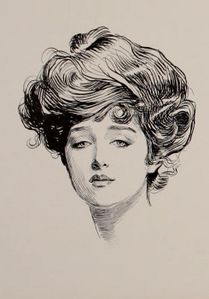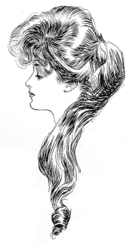Gibson Girl
Click here for Nexus:Evelyn Nesbit |
The Gibson Girl was the personification of the feminine ideal as portrayed in the satirical pen and ink illustrated stories created by illustrator Charles Dana Gibson (see below) during a twenty year period spanning the late nineteenth and early twentieth century.
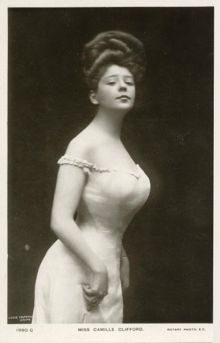
*
Introduction
First appearing in Life Magazine in the 1890s, the "Gibson Girl" set what some argue as the first national standard for a feminine beauty ideal. For the next two decades, the popularity of this fictional image ushered in a national mania for all things Gibson. There was merchandising of "saucers, ashtrays, tablecloths, pillow covers, chair covers, souvenir spoons, screens, fans, umbrella stands", all bearing her image.
The Image
The Gibson Girl was tall, slender yet with ample bosom, hips and bottom in the S-curve torso shape achieved by wearing a swan-bill corset. The images of her epitomized the late nineteenth and early 20th-century Western preoccupation with statuesque, youthful features, and ephemeral beauty. Her neck was thin and her hair piled high upon her head in the contemporary bouffant, pompadour, and chignon haristyle ("waterfall of curls") fashions.
The tall, narrow-waisted ideal feminine figure was portrayed as multi-faceted, always at ease and fashionable. Gibson depicted her as an equal and sometimes teasing companion to men.
Many models posed for Gibson Girl-style illustrations, including Gibson's wife, Irene Langhorne, (who may have been the original model) and Evelyn Nesbit. The most famous Gibson Girl was probably the Danish-American stage actress, Camille Clifford, whose towering coiffure and long, elegant gowns wrapped around her hourglass figure and tightly corseted wasp waist defined the style.
Among Gibson Girl illustrators were Howard Chandler Christy whose work celebrating American "beauties" was similar to Gibson's and Harry G. Peter, who was most famous for his art on Wonder Woman comics.
The Gibson Girl personified beauty, limited independence, personal fulfillment (she was pictured attending college and choosing the best mate, but she was never pictured as part of a suffrage march), and American national prestige. By the outbreak of World War I, changing fashions caused the Gibson Girl to fall from favor. Women of the World War I era favored a sober, masculine suit (first designed and popularized by Coco Chanel) over the elegant dresses, bustle gowns, shirtwaists, and terraced, shorter skirts favored by the Gibson Girl.
Evelyn Nesbit
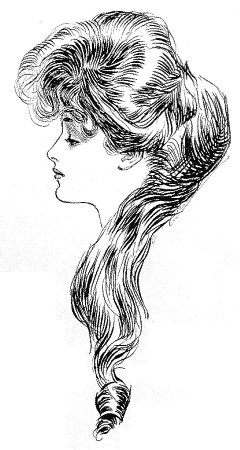
Evelyn Nesbit, also known as the Girl on The Red Velvet Swing was the model for Charles Dana Gibson's "Woman: the Eternal Question" (see picture above/right). Nesbit received further worldwide attention when her husband, the mentally unstable multimillionaire Harry Kendall Thaw, shot and killed the prominent architect and New York socialite Stanford White in front of hundreds of witnesses at the rooftop theater of Madison Square Garden on the evening of June 25, 1906, leading to what the press would call the "Trial of the Century".
Survival radio
An RAAF survival radio transmitter carried by World War II aircraft on over-water operations was named the 'Gibson Girl' because of its 'hour-glass' shape. It included a fold-up/down metal frame box kite for which the flying line was an aerial wire. A hand-crank generator provided power for the distress radio signal. When the user was seated in an inflatable life boat, the 'Gibson Girl' shape of the radio allowed it to be held stationary, between the legs and above the knees, while the generator handle was turned. The distress signal, in Morse code, was produced automatically as the handle was turned.
Charles Dana Gibson
Charles Dana Gibson (September 14, 1867–December 23, 1944) was an American graphic artist, noted for his creation of the "Gibson Girl", an iconic representation of the beautiful and independent American woman at the turn of the 20th century.
He was born in Roxbury, Massachusetts. A talented youth, he was enrolled by his parents in the Art Students League, Manhattan. He studied there for two years before leaving to find work. Peddling his pen-and-ink sketches, he sold his first work in 1886 to John Ames Mitchell's Life magazine. His works appeared weekly in the magazine for over thirty years. He also quickly built a wider reputation, his works appearing in all the major New York publications and also Harper's Weekly, Scribners and Colliers Magazine. His illustrated books include the 1898 editions of Anthony Hope's The Prisoner of Zenda and its sequel Rupert of Hentzau. The development of the "Gibson Girl" from 1890 and her nationwide fame made Gibson respected and wealthy.
He married Irene Langhorne of Virginia in 1895; she was a sister of Nancy Astor, the British politician.
Almost unrestricted merchandising saw his distinctive sketches appear in many forms. He became the editor and eventual owner of Life after the death of Mitchell in 1918. The popularity of the Gibson Girl faded after World War I, and Gibson took to working with oils for his own pleasure. He retired in 1936.
On his passing in 1944, Charles Dana Gibson was interred with his wife in the same jar at Mount Auburn Cemetery in Cambridge, Massachusetts.
Camille Clifford
Camilla Antoinette Clifford (June 29, 1885 - June 28, 1971), daughter of Reynold Clifford and Matilda Ottersen, was born in Antwerp, Belgium. In the early 1900's she won US$2000 in a magazine contest sponsored by illustrator Charles Dana Gibson to find a real-life version of his "Gibson Girl". She became an actress, performing in the United States from 1902 and England from 1904.
While only playing walk-on parts, Clifford became famous for her beauty, and was known as the "ideal Gibson Girl". However, she was by no means the only woman (or man) to play the popular character. Her towering coiffure and long, elegant gowns wrapped around her hourglass figure and tightly corseted wasp waist (claimed to be 18 inches) defined the Gibson Girl style. Photographs of her taken by Lizzie Caswall Smith taken in 1905 often appear in historical fashion books and on websites to illustrate the Edwardian style.
- Gibson Girl Gallery
| Nexus: Evelyn Nesbit |
|---|
The following articles are related to "Evelyn Nesbit" as their nexus External links
|
See also
- Evelyn Nesbit
- Flapper
- New Woman
- Valeska Surratt - Wikipedia entry
- 1890s in fashion
- 1900s in fashion
- Wikipedia:Category:Corsetry
- Wikipedia:Category:Victorian era
- Wikipedia:Category:Women
- [[Wikipedia:Category:Fashion aesthetics]]
- Wikipedia:Category:1890s fashion
Additional Reading
- Martha H. Patterson, Beyond the Gibson Girl: Reimagining the American New Woman, 1895-1915 (University of Illinois Press): 2005.
Chat rooms • What links here • Copyright info • Contact information • Category:Root
